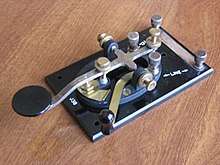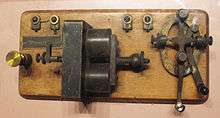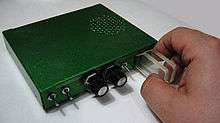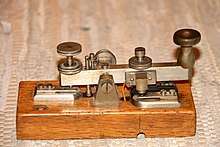Telegraph key
A telegraph key is a specialized electrical switch used by a trained operator to transmit text messages in telegraph systems, usually in Morse code. Keys are used in all forms of electrical telegraph systems, such as landline or "wire" electrical telegraphy, and "wireless", or radio telegraphy. An operator taps on the switch, connecting and disconnecting the electrical circuit, creating electrical pulses of two different lengths called "dots" and "dashes", to spell out text messages in code.


Types
Since its original inception, the telegraph key's design has developed such that there are now multiple types of keys.
Straight keys
A straight key is the common telegraph key as seen in various movies. It is a simple bar with a knob on top and a switch underneath. When the bar is pressed down against spring tension, it makes a closed electric circuit. Traditionally, American telegraph keys had flat topped knobs and narrow bars (frequently curved), while British telegraph keys had ball shaped knobs and thick bars. This appears to be purely a matter of culture and training, but the users of each are tremendously partisan. Straight keys have been made in numerous variations for over 150 years and in numerous countries. They are the subject of an avid community of key collectors. The straight keys used in wire telegraphy also had a shorting bar that closed the electrical circuit when the operator was not actively sending messages. This was to complete the electrical path to the next station so that its sounder would operate, as in the operator receiving a message from the next town. Although occasionally included in later keys for reasons of tradition, the shorting bar is unnecessary for radio telegraphy, except as a convenience when tuning the transmitter.
The straight key is simple and reliable, but the rapid pumping action needed to send a string of dots (or dits as most operators call them) poses some significant drawbacks.
Transmission speeds vary from 5 words (25 characters) per minute, by novice operators, up to about 30 words (150 characters) per minute by skilled operators. In the early days of telegraphy, a number of professional telegraphers developed a repetitive stress injury known as glass arm or telegrapher's paralysis. "Glass arm" or "telegrapher's paralysis" may be reduced or eliminated by increasing the side play of the straight key by loosening the adjustable trunnion screws. Such problems can be avoided by using a good technique.[1][2][3]
Alternative designs
In addition to the basic up-and-down telegraph key, telegraphers have been experimenting with alternate key designs from the beginning of telegraphy. Some are mede to move side-to-side instead of up-and-down. Some of the designs, such as sideswipers and semi-automatic keys operate mechanically. From the mid-20th century electronic devices called "keyers" have been developed, operated by special keys of various designs generally categorized as single-paddle keys and "iambic" or double-paddle keys.
- Sideswipers
The first widely accepted alternative key was the sideswiper or sidewinder, sometimes called a cootie key or bushwhacker. This key uses a side-to-side action with contacts in both directions and the arm spring-loaded to return to center. A series of dits could be sent by rocking the arm back and forth. The alternating action produces a distinctive rhythm or swing which noticeably affects the operator's transmission style (known as his ‘fist’). Although the original sideswiper is now rarely seen or used, nearly all advanced keys use some form of side-to-side action.
- Semi-automatic key
A popular side-to-side key is the semi-automatic key or bug, sometimes known as a Vibroplex key, after the company that first manufactured them. The original bugs were fully mechanical, based on a kind of simple clockwork mechanism, and required no electronic keyer. When the paddle is pressed to the left it makes a continuous contact suitable for sending dashes (or dahs, as most operators call them). When the paddle is pressed to the right, it kicks a horizontal pendulum which then rocks against the contact points, sending a series of short pulses (dits) at a speed which is controlled by the position of the pendulum’s weight. A skilled operator can achieve sending speeds in excess of 40 words per minute with a ‘bug’.
- Electronic keyers and paddle keys
Like semi-automatic keys, the telegrapher operates an electronic keyer paddle by swinging the lever from side-to-side. When pressed to one side, the keyer electronics generate a series of "dahs"; when pressed to the other side, a series of "dits." Keyers work with two different types of keys: single paddle and double paddle keys. Like semi-automatic keys, pressing the paddle on one side produces a dit and the other a dah. Single paddle keys are also called single lever keys or sideswipers, the same name as the older side-to-side key design they greatly resemble. Double paddle keys are also called "iambic"[lower-alpha 1] keys or "squeeze" keys.
Single paddle keys are essentially the same as sideswiper keys with separate contacts on the left and right. Double-paddle keys have two arms, one for each contact, both arms held away from the common center by a spring; pressing either of the paddles towards the center makes contact, the same as pressing a single-lever key to one side. For double-paddle keys, squeezing both paddles together makes a double-contact, which causes the keyer to send alternating dits and dahs.
Most electronic keyers include dot and / or dash memory functions, so the operator do not need to use perfect spacing between dits and dahs or vice versa. With dit or dah memory, the operator's keying action can be about one dit ahead of the actual transmission. The electronic keyer adjusts the timing so that the output of each letter is machine-perfect. Electronic keyers allow very high speed transmission of code.

Using a keyer in what's called "iambic" mode requires a key with two paddles: One paddle produces dits and the other produces dahs. Pressing both at the same time produces an alternating dit-dah-dit-dah sequence, which starts with either a dit or dah depending on which side was pressed first.
An additional advantage of electronic keyers over semiautomatic keys is that code speed is easily changed with electronic keyers, just by turning a knob. With a semiautomatic key, the location of the pendulum weight and the pendulum spring tension and contact must be re-balanced to change the dit speed.[4]
Dual-lever paddles
Keys having two separate levers, one for dits and the other for dahs are called dual or dual-lever paddles. With a dual paddle both contacts may be closed simultaneously, enabling the "iambic" functions of an electronic keyer that is designed to support them. The operator can create a series of alternating dits and dahs (similar to a sequence of iambs in poetry) by squeezing the levers together.[5][6] For that reason, dual paddles are sometimes called squeeze keys. Whether the sequence begins with a dit or a dah is dependent on which lever is closed first. If the dah lever is closed first, then the first element will be a dah, so the string of elements will be similar to a sequence of trochees in poetry and the method could as logically be called "trochaic keying". Insofar as iambic keying is a function of the electronic keyer, it is technically incorrect to refer to a dual paddle as an "iambic" paddle, although this has often been done for marketing purposes. A dual paddle is required for iambic sending with an iambic keyer, but it can be used without squeezing and there are electronic keyers which do not offer iambic functions.
A single-paddle also utilizes separate contacts for dits and dahs, but there is no ability to make both contacts simultaneously by squeezing the paddles together (iambic). When a single-paddle key is used with an electronic keyer, continuous dits are created by holding the dit side. Likewise, continuous dahs are created by holding the dah contact.
Iambic keying or squeeze keying creates alternating dits and dahs. This reduces the keystrokes or hand movements necessary to make some characters, e.g. the letter C, which can be sent by merely squeezing the two paddles together. With a single-paddle or non-iambic keyer, the hand motion would require alternating four times for C (dah-dit-dah-dit).
Iambic keyers function in one of at least two major modes: mode A and mode B. Mode A is the original iambic mode, in which alternate dots and dashes are produced as long as both paddles are depressed. When the paddles are released, the keying stops with the last dot or dash that was sent while the paddles were depressed.
Mode B is the second mode, which devolved from a logic error in an early iambic keyer. Over the years iambic mode B has become something of a standard and is the default setting in most keyers. In mode B, dots and dashes are produced as long as both paddles are depressed. When the paddles are released, the keying continues by sending one more element, i.e., a dot if the paddles were released during a dash, or a dash if the paddles were released during a dot. Users accustomed to one mode may find it difficult to adapt to the other, so most modern keyers allow selection of the desired keyer mode.
A third electronic keyer mode useful with a dual paddle is the "Ultimatic" mode, named for the electronic keyer that introduced it. In the Ultimatic keying mode, the keyer will switch to the opposite element if the second lever is pressed before the first is released (that is, squeezed).
Typically, single and dual-paddle keys use horizontal movements, while a straight-key utilizes an up-and-down movement. The efficiency of iambic keying has recently been discussed in terms of movements per character and timings for high speed CW.[7]
Non-telegraphy uses
Simple telegraph-like keys were long used to control the flow of electricity in laboratory tests of electrical circuits. Often, these were simple "strap" keys, in which a bend in the key lever provided the key's spring action. Telegraph keys were once used in the study of operant conditioning with pigeons. Starting in the 1940s, initiated by B. F. Skinner at Harvard University, the keys were mounted vertically behind a small circular hole about the height of a pigeon's beak in the front wall of an operant conditioning chamber. Electromechanical recording equipment detected the closing of the switch whenever the pigeon pecked the key. Depending on the psychological questions being investigated, keypecks might have resulted in the presentation of food or other stimuli. Modern pigeon response keys are specially made switches but are still called "keys" due to their origins as telegraph keys.
"Fist"
With straight keys, side-swipers, and, to an extent, bugs, each and every telegraphist has their own unique style and pattern when transmitting a message. An operator's style is known as their "fist". To other telegraphers, every fist is unique and can be used to identify the telegrapher transmitting a particular message. This had a huge significance in the world wars, as it could be used to track the location of individual ships and submarines. See traffic analysis. However, electronic keyers (single-paddle or iambic) will produce "perfect" code at a set speed, thus only inter-character and inter-word spacing can produce a semblance of a fist.
See also
Notes
- The name "iambic" comes from the rhythm in poetry, which the sound of the beat of alternating dits and dahs resembles. E.g. "Of cloudless climes and starry skies" ≈ dit dah dit dah dit dah dit dah.
References
- How to operate a straight key on YouTube.
- Technique Of Hand Sending (1944) on YouTube.
- Straight Key hand sending technique as approved by professionals on YouTube.
- How to Properly Adjust and Use a Vibroplex Bug (video) – via YouTube.
- Arduino CW Keyer, K3NG.
- How to use an iambic keyer on YouTube.
- Iambic Keying – Debunking the Myth, Marshall G. Emm, N1FN.
External links
| Wikimedia Commons has media related to Telegraph keys. |
- Sparks Telegraph Key Review - A pictorial review of telegraphy and telegraph keys with an emphasis on spark (wireless) telegraphy.
- The Telegraph Office - A resource for telegraph key collectors and historians
- The Keys of N1KPR
- The Art and Skill of Radio Telegraphy
- Development of the Morse Key
- Telegraph Keys - An online resource for identification of all types of telegraph instruments
